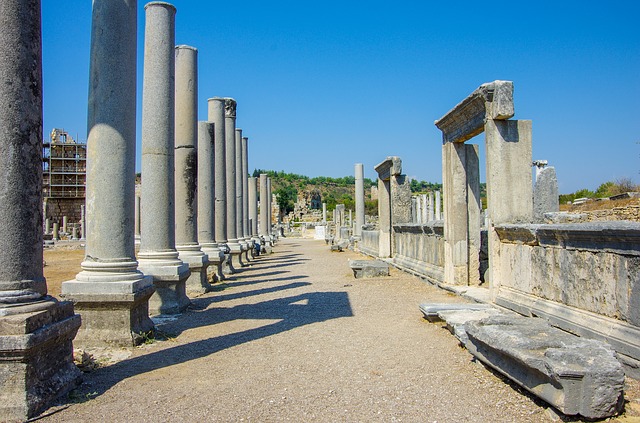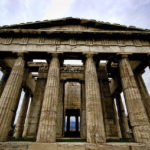Following Alexander to Perge, Southern Turkey

Perge may be one of the most impressive Roman/Hellenistic ruins in Southern Turkey, but for me, Alexander’s ghost lured me to visit this ancient place.
I fell in love with Alexander the Great while in middle school, after reading Mary Renault’s The Alexander Trilogy, evocative novelized tellings of the great, beautiful and beloved conquerer.
Tutored by Aristotle, Alexander of Macedonia not only took charge of an army at 18, but also went on to conquer Persia, Thrace, Egypt and India. Regarded as one of the most brilliant military minds in the history of the world, Alexander was a romantic too, and strangely accepting of other cultures for his time. He died just short of his 33rd year. For a 13 year old girl, he was my “girlhood crush,” my Teen Beat hero.
To this day, I get slightly weak in the knees when I envision Alexander and what it would have been like to stand in his shadow and speak with him, just once.
The Perge ruins are roughly 10 miles outside of Antalya, and were the first Roman ruins I’d set foot in.
So, while in Antalya, Turkey, when I heard Alexander the Great not only conquered the ancient Pamphylia city of Perge, but was welcomed with open arms in 333 BCE, I jumped at the chance to tour the ruins and walk along the same streets and marbled columns as my historic crush once did.
The Perge ruins are roughly 10 miles outside of Antalya, and were the first Roman ruins I’d set foot in. Located between two major rivers, Perge was apparently founded after the Trojan War by the Greeks, though tablets recently discovered suggest the city was inhabited even earlier. I’d never actually been to an ancient city ruins before, Roman or otherwise. I wasn’t disappointed, and I was thrilled that my first ruins would include the ghosts of my first “crush.”
History of Perge
Although historians say Perge was settled by Greeks following the Trojan War, ancient Hittite tablets suggest the area was inhabited as early as 1500 BCE. After Alexander’s invasion and subsequent death, the city fell under the rule of the Ptolemaic and Seleucid Dynasties. The Romans took over in 188 BCE, and in 43 CE, Phamphylia was officially brought into the Roman Empire.
Like many other major cities, Perge flourished under Roman rule, but centuries later, the city declined under attacks from Arabs and other cultures. Throughout its later history, Perge served as home to the Selcuk Turks in the 9th century and the Ottomans in the late 1300s.
Perge had its favorite son as well, the mathematician Apollonius, a student of Archimedes.
Archaeological excavations in Perge began in 1946 and the excavations are still ongoing. While the theatre is one of the most impressive sights at Perge, it is not open to the public due to excavations.
Researchers are still finding treasures in Perge. In July, a new mosaic was found that depicts the sacrifice of Iphigenia, daughter of Agamemnon and Clytemnestra during the Trojan War. The mosaic, estimated to be 1,800 years old, was discovered in the basement of a shop located along the west street in Perge.
Wandering the City
My first real glimpse of Perge’s ruins were the rows and rows of broken columns just lying out in the grass, with nothing to keep tourists like me from climbing all over them. A massive gate loomed before opening up into a courtyard, and I imagined Alexander turning his eyes up as he too passed into the city of Perge.
When I visited, I didn’t realize these massive block-like gates didn’t exist during Alexander’s invasion. Only the round Hellenistic towers, which still stand despite centuries of crumbling, served as the gates to the city. In Alexander’s day, Perge didn’t have walls. These came later, but also came down under Roman rule, and another entrance gate was built.
That blocky entrance gate was the first I walked beneath, but the rounded Hellenistic Towers, built in the 3rd century BCE, would have made an impressive sight to my young conquerer.
During Roman rule, visiting the baths would have been customary for a visitor of note, and that’s one of the first places I explored.
Perge, a blend of Hellenistic and Roman construction, must have seemed cosmopolitan at the time, with its massive U-shaped stadium that seated roughly 15,000 people, or the theater, which is closed off to visitors. During Roman rule, visiting the baths would have been customary for a visitor of note, and that’s one of the first places I explored.
Built approximately in the second century, the remains of the Roman baths with its nearly intact hypocaust floor heating system, still has bits of the original marble flooring. Wandering around the outer and inner areas of the baths it’s easy to imagine men coming straight from the gymnasium (which can also be seen at Perge) to lounge and talk politics.
I sat on one of the marble benches, rubbing my hands along the smooth surface to try to absorb the memories of the people who lived here. Touching history is a bad habit I picked up as a kid when I explored my first castle in Germany aged eight. In many historic places, touching is not allowed, yet my skin yearns to feel what souls centuries earlier felt.
In a way, touching these stones bend time, creates a link between the people of the past and my modern hands.
Luckily, in Perge, you can touch. You can walk down the colonnaded streets with its impressive rows of columns, your feet skipping over ruts left by Roman chariots. In fact, you can slide your palm over the stone Ionic columns that lead to the Agora, or marketplace, which was built in the 4th century BCE.
You can almost see the ghosts of crowds carrying baskets of goods, gossiping with friends as they shopped.
Built in a perfect square, the Agora would have included stores like butcher shops, fabric stores and everything in between. You can almost see the ghosts of crowds carrying baskets of goods, gossiping with friends as they shopped.
Perge also includes remains of the gymnasium, the necropolis, two Nymphaeums (which provided the water source), the remains of the Tomb of Placia Magna (a priestess of Artemis) and a bit of the Byzantine basilica.
If you love taking photos, the ruins of Perge are awash with sights to capture. And the history of the city itself will leave you mesmerized. Plus, it was one of the first cities to produce beer, which also makes it a favorite in my heart.
Plenty of bus tours visit Perge from Antalya. They also visit neighboring Aspendos, another ancient city with one of the best-preserved Roman theatres in the area. If you’re driving alone, pick up the guidebook at the entrance of Perge. This helps explain all the different areas of the old city, as well as its history.
Perge is open to visitors from 9 a.m. to 7 p.m. daily from April to October, and from 8:30 to 5:30 p.m. in the winter. Tickets are 20 Turkish Lira. Another great stop to learn more about Perge is the Archeological Museum in Antalya. They house finds and sarcophagi from the Perge site.
Following Alexander to Perge, Southern Turkey
Related Reading
- Exploring Off-the-Beaten-Path Neighborhoods in Istanbul
- Discovering My Turkish Roots in Istanbul
- How Turkish Culture Forced Me to Relax
- Three Truths about Typical Turkish Men
- Turkish Mosques: Experiencing Religion in Turkey
- Tips for Women Travelers in Turkey
- 10 Turkish Phrases You’ll Want To Know
- How to Take a Babymoon in Turkey
- Touring Turkey: A Conversation with Zondra Wilson
- Turkish Customs: The Social Event of a New Home
Have you traveled to Turkey? What were your impressions? Email us at editor@pinkpangea.com for information about sharing your experience and advice with the Pink Pangea community. We can’t wait to hear from you!
Following Alexander to Perge, Southern Turkey photo credit: unsplash








